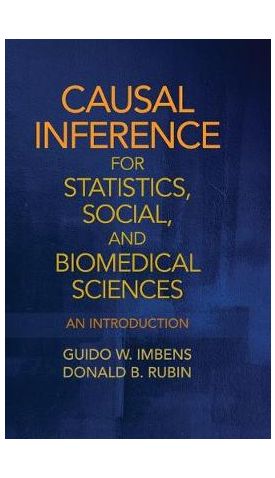אנו משתמשים ב-Cookies כדי לשפר את החוויה שלך. כדי לקיים ההנחיה החדשה של e-Privacy, עלינו לבקש את הסכמתך להגדיר את ה-Cookies. קבלת מידע נוסף.
273.00 ₪
Causal Inference for Statistics, Social, and Biomedical Sciences: An Introduction
273.00 ₪
ISBN13
9780521885881
יצא לאור ב
New York
עמודים / Pages
644
פורמט
Hardback
תאריך יציאה לאור
6 באפר׳ 2015
This text presents statistical methods for studying causal effects and discusses how readers can assess such effects in simple randomized experiments.
Most questions in social and biomedical sciences are causal in nature: what would happen to individuals, or to groups, if part of their environment were changed? In this groundbreaking text, two world-renowned experts present statistical methods for studying such questions. This book starts with the notion of potential outcomes, each corresponding to the outcome that would be realized if a subject were exposed to a particular treatment or regime. In this approach, causal effects are comparisons of such potential outcomes. The fundamental problem of causal inference is that we can only observe one of the potential outcomes for a particular subject. The authors discuss how randomized experiments allow us to assess causal effects and then turn to observational studies. They lay out the assumptions needed for causal inference and describe the leading analysis methods, including matching, propensity-score methods, and instrumental variables. Many detailed applications are included, with special focus on practical aspects for the empirical researcher.
| עמודים / Pages | 644 |
|---|---|
| פורמט | Hardback |
| ISBN10 | 0521885884 |
| יצא לאור ב | New York |
| תאריך יציאה לאור | 6 באפר׳ 2015 |
| תוכן עניינים | Part I. Introduction: 1. The basic framework: potential outcomes, stability, and the assignment mechanism; 2. A brief history of the potential-outcome approach to causal inference; 3. A taxonomy of assignment mechanisms; Part II. Classical Randomized Experiments: 4. A taxonomy of classical randomized experiments; 5. Fisher's exact P-values for completely randomized experiments; 6. Neyman's repeated sampling approach to completely randomized experiments; 7. Regression methods for completely randomized experiments; 8. Model-based inference in completely randomized experiments; 9. Stratified randomized experiments; 10. Paired randomized experiments; 11. Case study: an experimental evaluation of a labor-market program; Part III. Regular Assignment Mechanisms: Design: 12. Unconfounded treatment assignment; 13. Estimating the propensity score; 14. Assessing overlap in covariate distributions; 15. Design in observational studies: matching to ensure balance in covariate distributions; 16. Design in observational studies: trimming to ensure balance in covariate distributions; Part IV. Regular Assignment Mechanisms: Analysis: 17. Subclassification on the propensity score; 18. Matching estimators (Card-Krueger data); 19. Estimating the variance of estimators under unconfoundedness; 20. Alternative estimands; Part V. Regular Assignment Mechanisms: Supplementary Analyses: 21. Assessing the unconfoundedness assumption; 22. Sensitivity analysis and bounds; Part VI. Regular Assignment Mechanisms with Noncompliance: Analysis: 23. Instrumental-variables analysis of randomized experiments with one-sided noncompliance; 24. Instrumental-variables analysis of randomized experiments with two-sided noncompliance; 25. Model-based analyses with instrumental variables; Part VII. Conclusion: 26. Conclusions and extensions. |



Login and Registration Form